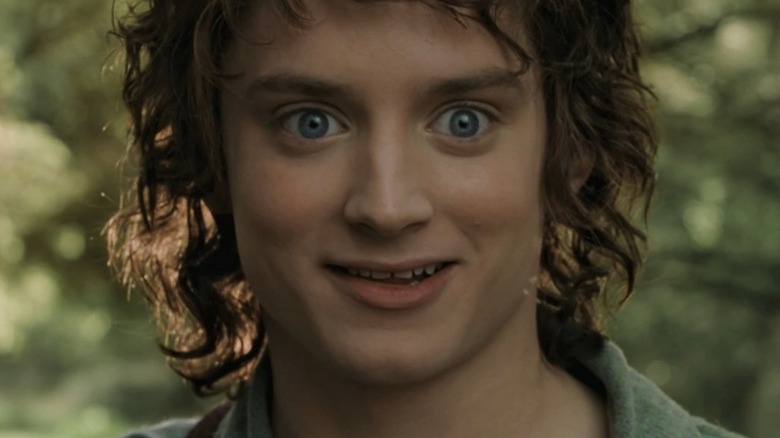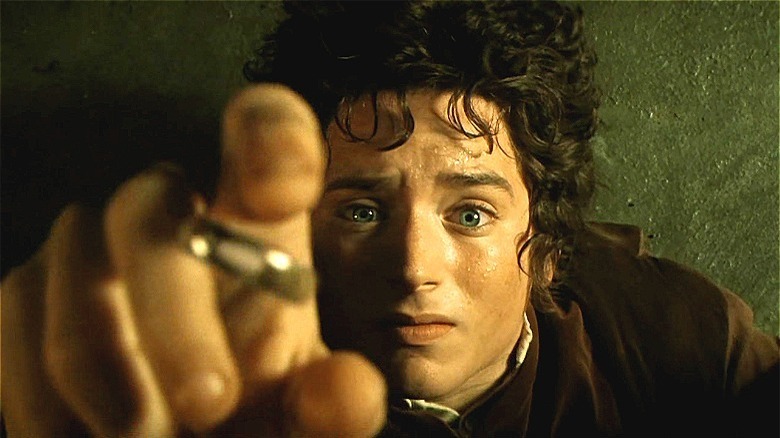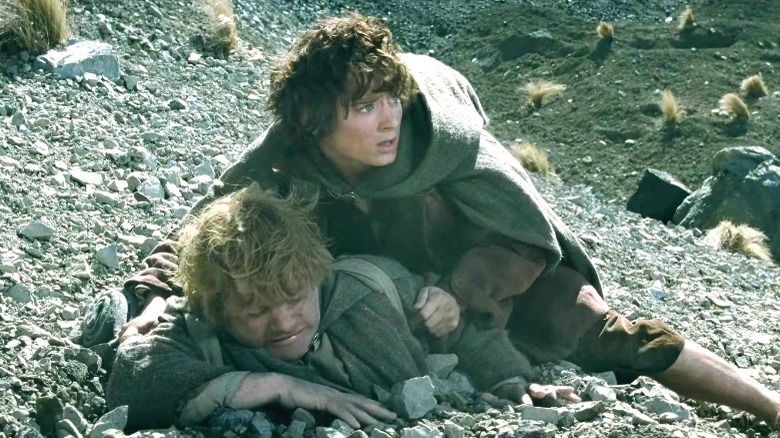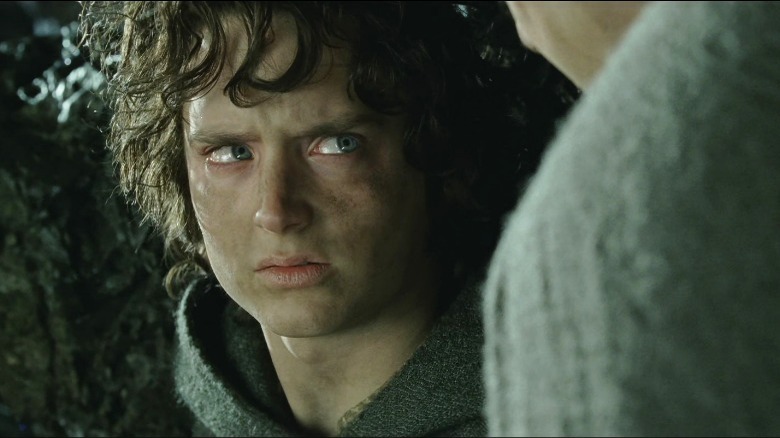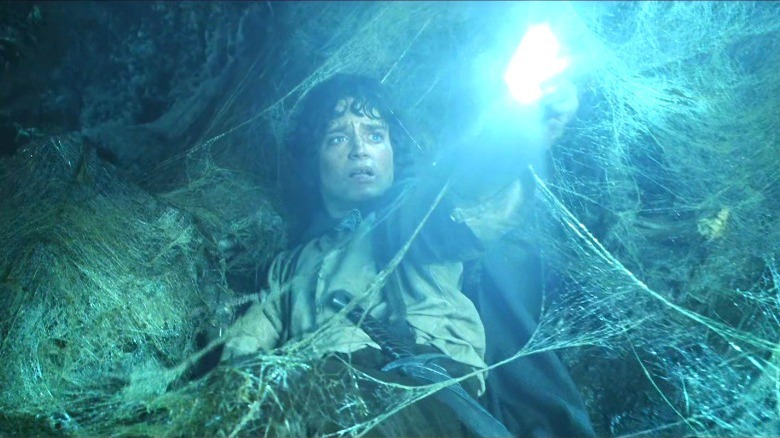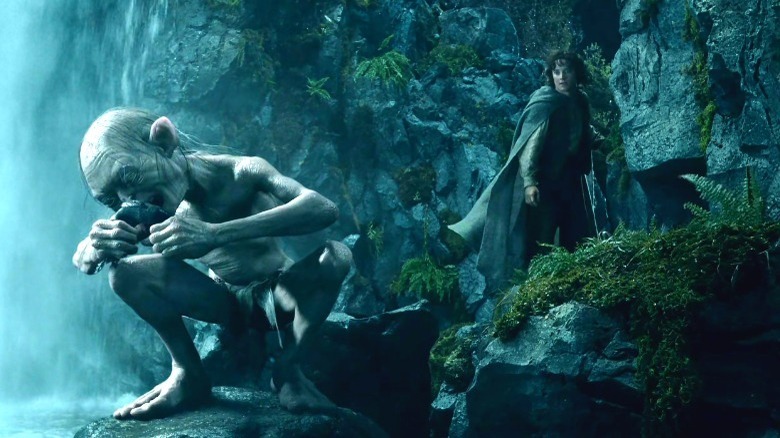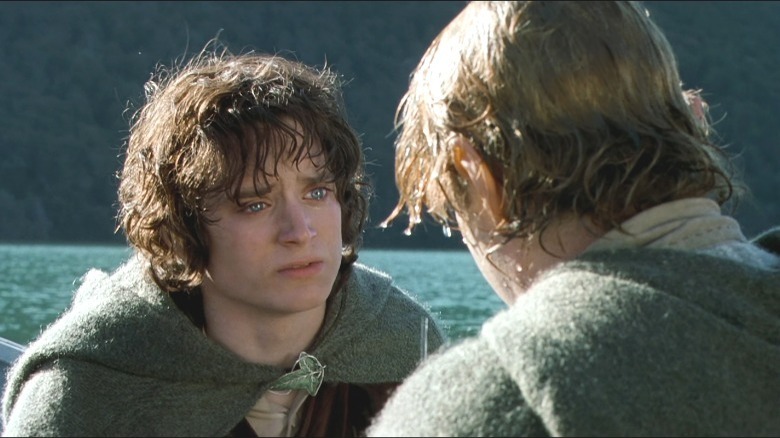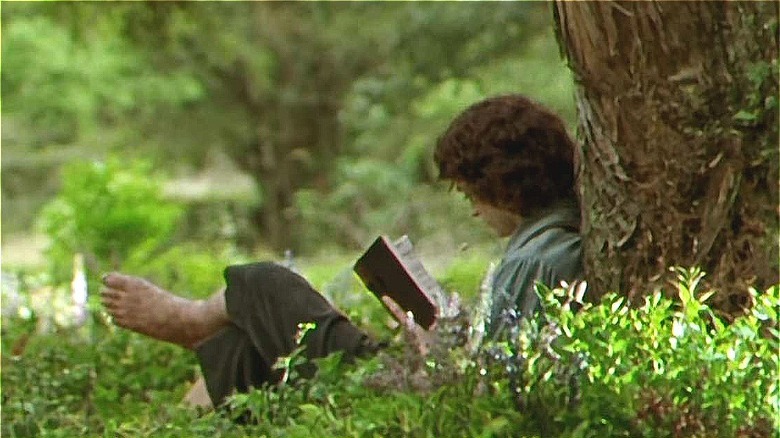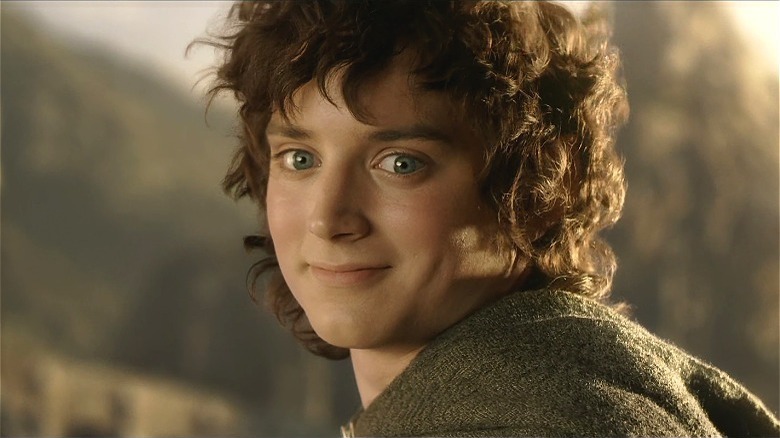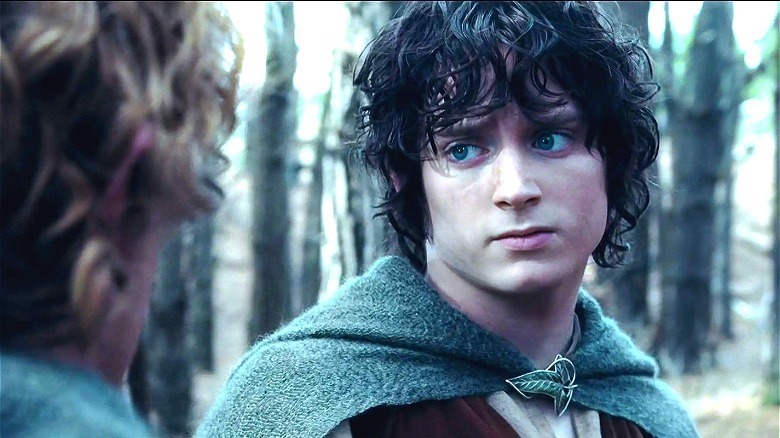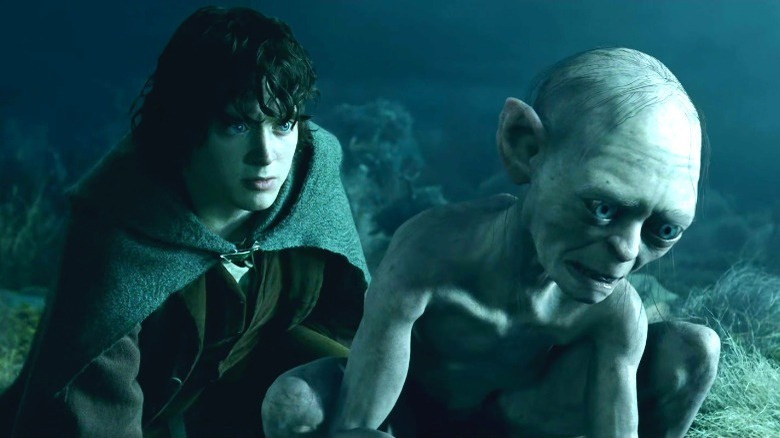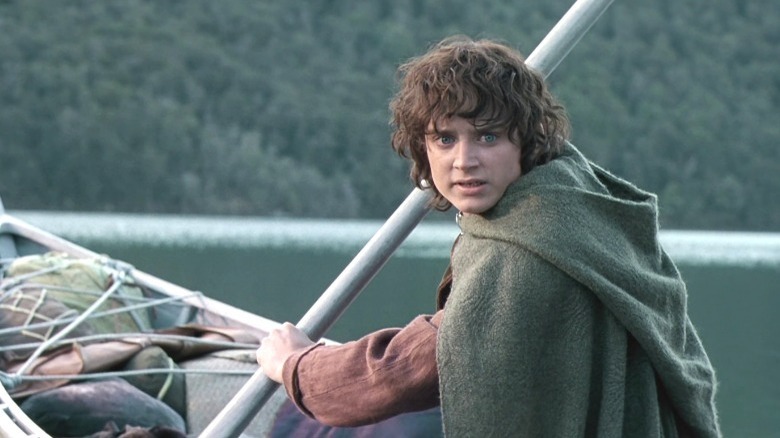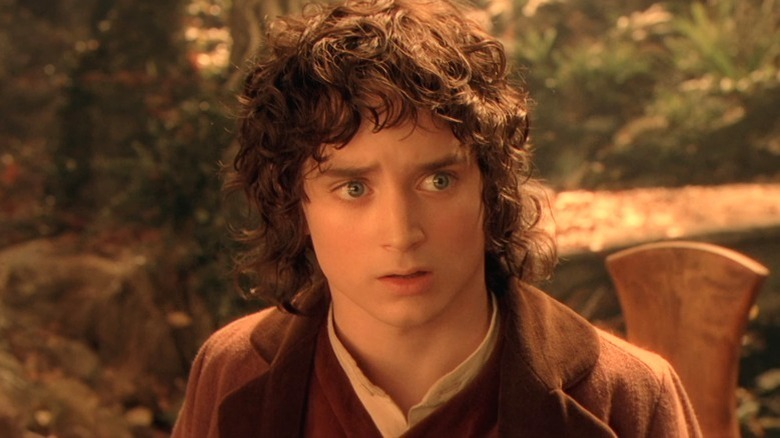Frodo Baggins' 12 Best Moments In The Lord Of The Rings Franchise Ranked
Peter Jackson's "The Lord of the Rings" movie trilogy is a genuine classic that still holds up well 20 years after its theatrical release. Based on the high fantasy novels by J.R.R. Tolkien, the films tell an epic tale of good versus evil, and how good always wins in the end. In the world we are currently living in, revisiting this theme may be a necessary comfort for many of us.
"The Lord of the Rings" is filled to the brim with fascinating characters, from noble heroes to fiendish villains and everything in between. Fans of the movies certainly have their favorites: Merry (Dominic Monaghan) and Pippin (Billy Boyd) are the perfect mischievous duo, Eowyn (Miranda Otto) is a feminist icon, and Aragorn (Viggo Mortensen) is the epitome of the noble fantasy hero. Yet strangely, the main protagonist of the trilogy is often overshadowed.
Frodo Baggins (Elijah Wood), like his predecessor and uncle Bilbo Baggins (Ian Holm), is a hobbit from the Shire who is thrust from his pastoral life into a quest filled with perilous trials. He may not be a great warrior or wield powerful magic, but Frodo has many traits that make his character an integral part of the story and lead to some of the finest moments in "The Lord of the Rings." Here are 12 of Frodo Baggins's best moments, ranked.
12. The first time Frodo puts on the Ring
After Gandalf (Ian McKellen) entrusts Frodo with the One Ring, Frodo goes to Bree with his hobbit companions to meet Gandalf at the Prancing Pony Inn, where they will then travel together to Rivendell. Unfortunately, when the hobbits arrive, the Gray Wizard is nowhere to be found.
Frodo knows that Sauron's forces are looking for a hobbit named Baggins, so he uses the name Underhill to hide his identity outside of the Shire. But when Pippin gets a little too friendly with the locals at the tavern, he blows Frodo's cover and causes the hobbit to panic. As Frodo rushes to stop Pippin from saying more, he trips and falls and the One Ring slips from his grasp. Frodo reaches out to catch it, and the Ring accidentally slips onto his finger, causing him to vanish.
Though Frodo is invisible to those around him, he finds himself in an eerie otherworld, colorless and dark, with a deafening wind whipping around him. He is then confronted by a giant eye circled by fire — the Eye of Sauron. Frodo quickly removes the Ring, but the damage is done — Sauron now knows that the One Ring has been found.
This scene is so important because it helps the audience to understand why the One Ring is so powerful, and why it is so dangerous to put it on. Plus ... it just looks cool.
11. Frodo's quick thinking saves his and Sam's lives
The realm of Mordor is a treacherous place, with many dangers that threaten to impede Frodo and Sam (Sean Astin) on their journey. By a stroke of good luck, they come upon Gollum (Andy Serkis), who agrees to lead them to the dark region's gates. When they arrive at the threshold in "The Two Towers," they see an army of humans loyal to Sauron, called Easterlings, marching into Mordor.
Though they try to stay hidden from the soldiers, the rock that Sam is holding onto breaks off and he begins to slide down the hill. Frodo runs down the steep hillside after Sam as two Easterling soldiers break away to investigate the commotion. Unfortunately, Sam is trapped under the rocks and can't get out, and Frodo isn't strong enough to free him in time. As the soldiers get closer, Frodo quickly throws his Elvish cloak over himself and Sam. When the men approach, they only see a large boulder that blends into the hill. As they return to their regiment, Frodo throws back the cloak, revealing the illusion that kept the hobbits from being discovered.
The scene is brimming with suspense as the hobbits hold their breath, watching the Easterling soldiers through the cloak's material. A thin strip of fabric is all that separates the hobbits from certain doom, and it's all thanks to the magic of the Elven cloaks gifted by Galadriel (Cate Blanchett) — and, of course, Frodo's quick thinking.
10. Frodo sends Sam away
Frodo arguably makes a huge mistake when he sends Sam away in "The Lord of the Rings: The Return of the King." How can he do such a terrible thing to such a loyal companion? But looking at it from a different angle, it might be one of the best things that Frodo does.
In the movie, Gollum leads Sam and Frodo up the steep, hazardous steps of Cirith Ungol. Day by day, Frodo's control over his faculties is waning as the Ring exerts its power over him. Sam knows that Frodo is growing weaker, and he also knows that Gollum is up to no good. After Gollum throws away the last of the hobbits' food and frames Sam, things between Sam and Gollum reach a breaking point. Sam attacks Gollum, and Frodo quickly sends Sam away, much to Gollum's delight and Sam's detriment.
While his actions might seem cruel, it could be that Frodo is making one last-ditch effort to protect his dearest friend. He knows how difficult the journey has been for Sam, and he is afraid that his loyal sidekick will also fall victim to the Ring's power. By sending him away, Frodo is actually hoping to save him.
Whether his actions are motivated by selflessness or anger is debatable, but we must also consider the outcome: if Frodo does not send Sam away, Sam might also fall victim to the monstrous Shelob and not be able to come to Frodo's rescue.
9. Frodo stands against Shelob
Arachnophobia is one of the most common phobias in the world, with 3%-15% of the population being affected (via Cleveland Clinic). Even "Rings" director Peter Jackson admits to having it. In fact, he based the design of the horrifying Shelob in "The Lord of the Rings: The Return of the King" on his childhood fear of tunnel web spiders (per The One Ring).
One of the most frightening sequences in the final film of the "LOTR" trilogy has Frodo racing through the web-covered tunnels to escape the giant spider. After sending Sam away and realizing Gollum's treachery, Frodo is utterly alone and seemingly without hope. However, he remembers the words of Galadriel and the gift of the Star of Earendil. Uttering a spell in Elven, he uses the light from the Phial of Galadriel to fend off the eight-legged terror.
Barely managing to escape the beast's clutches, Frodo stumbles out of the cave and falls to the ground, exhausted. No one could blame him if he gave up at that moment, with everything that has transpired. Yet when Galadriel appears to him in a vision, offering him a kind smile and encouraging words, Frodo finds his willpower once more and keeps going.
8. He stops Faramir from killing Gollum
In "The Lord of the Rings: The Two Towers," Frodo and Sam meet Faramir (David Wenham), a captain of Gondor and brother of the late Boromir who is hiding out in a series of caves with his men. They take Sam and Frodo captive, but Gollum manages to slink away unseen.
Frodo is wakened in the middle of the night by Faramir, who takes him to a secret pool below the caves where they spy Gollum. Suspecting that Frodo has been dishonest with him, Faramir signals to his men to ready their bows and shoot the trespasser. At the last moment, Frodo admits the truth to Faramir that Gollum is bound to him, and is guiding them to Mordor. He pleads for Gollum's life and assists Faramir in taking Gollum captive for interrogation. It is then that Faramir learns that Frodo possesses the One Ring, and finds himself tempted to take the Ring to his father in Gondor.
For Gollum, Frodo's actions feel like a betrayal. As a result, Gollum's faith in his hobbit master abruptly wanes, and he begins secretly plotting against him — not knowing that Frodo's actions possibly saved his life. Whether or not Faramir was bluffing about killing the wretched creature, Frodo had no choice but to reveal his association with Gollum or else lose his guide. Frodo's sympathy for Gollum plays a huge factor in his decision — he can't just stand by and watch Gollum be killed.
7. Frodo saves Sam from drowning
At the end of "The Lord of the Rings: The Fellowship of the Ring," the Fellowship has broken, Gandalf has fallen in battle against the Balrog, and Boromir has been killed. Meanwhile, Frodo has decided that it would be better to continue to Mordor alone rather than put his friends in any more danger. He sneaks away from the group to one of the boats by the river and starts to row away. Moments later, Sam runs after him, jumping into the water to chase after his best friend — even though he doesn't know how to swim.
This moment has been lauded as one of Sam's best, but it is also momentous for Frodo as well. As Sam begins to drift underneath the water, Frodo's hand reaches under the surface to pull Sam upward, saving him from drowning. Of course, we know that Frodo won't let his faithful gardener die, but the action is even more noteworthy for those who know about Frodo's history.
In the book "The Fellowship of the Ring," it's said that Frodo is raised by his uncle, Bilbo Baggins, after Frodo's parents die. The manner of their death is mysterious, but the book says that Frodo's mother and father drown in a boating accident. Upon seeing his friend nearly die in the same way as his parents, Frodo could understandably be triggered thanks to his tragic past — yet he manages to hold it together enough to rescue Sam from certain doom.
6. Frodo's first moment on screen
The prologue for "The Lord of the Rings: The Fellowship of the Ring" gives the audience an epic tale within the first seven minutes of the film. In that short amount of time, we learn about the creation of the One Ring of Power, the Alliance of Elves and Men, the downfall of Sauron, and the betrayal of Isildur of Gondor (Harry Sinclair). We are also brought up to speed on the events just before "The Fellowship of the Ring," like the tale of how Bilbo found the One Ring in "The Hobbit."
After this dark and foreboding introduction, the movie then cuts to the peaceful landscape of the green woods and fields of Hobbiton. There we see a curly-haired hobbit sitting beneath a tree reading a book. When he hears a deep voice off in the distance humming a tune, the hobbit jumps to his feet with a grin of excitement and rushes off to meet the newcomer. It is, of course, his dear friend Gandalf, who has come to celebrate Bilbo's birthday.
This is how the film introduces Frodo Baggins, who becomes such an important and somewhat tragic figure in "The Lord of the Rings." When we first meet him, Frodo is in his element — peaceful, contemplative, and ideally at home. It's one of his last moments of peace and innocence before his life changes forever.
5. Frodo says farewell
There are many emotional moments throughout "The Lord of the Rings" movies. From tragic deaths to ecstatic triumphs, there are scenes in all three films that have the potential to bring a tear to your eye. As it happens, one of Frodo's most emotional moments is also one of his best.
After the defeat of Sauron in "The Return of the King," and after Aragorn takes his rightful place on the throne of Gondor, hobbits Merry, Pippin, Sam, and Frodo return once more to their home in the Shire. Despite the relief that their peaceful lives are now safe, each of them knows that something isn't quite right. Just like Tolkien when he returned home from World War I in 1918 (per Tolkien Society), post-traumatic stress disorder (PTSD) begins to weigh heavily on the four hobbits – and Frodo in particular.
In order to heal, Frodo decides that it is time to leave Middle-earth and join Bilbo (along with Galadriel, Elrond, and Gandalf) in the realm of Valinor in the west. Normally this honor is reserved for elves, but because both Bilbo and Frodo were once bearers of the One Ring, they are also granted passage. At this realization that their dearest friend will be leaving forever, the other three hobbits break down into tears.
After everything Frodo has been through, he above all deserves to live out the rest of his life in peace. Though we can understand why Frodo has made this choice, we can't help but bawl our eyes out every time.
4. Frodo gives Sam due credit
It has long been debated among fans of "The Lord of the Rings" whether Samwise Gamgee is the true hero of the series. His undying loyalty, endless optimism, and unwavering bravery are demonstrated time and time again throughout the trilogy. Some might argue that Frodo contributes very little to the quest itself (not us), and that it's really Sam who deserves most — if not all — of the credit.
However, some fans seem to forget that Frodo is very well aware of how much Sam has done. In one of the final scenes in "The Lord of the Rings: The Two Towers," Sam and Frodo are walking through a forest as Sam ruminates on the stories that will be told of their adventures. In his version of the tale, Frodo is named the hero. However, Frodo reminds him that Sam also had a big part to play, calling him "Samwise the Brave." "I was being serious," Sam says, believing that Frodo is teasing him. "So was I, Sam," Frodo replies, his expression sincere.
At this moment, Frodo says out loud what the audience already knows. While Frodo is also courageous and determined to carry out his mission, he realizes that he never would have gotten this far without his dearest friend. It's good to see Frodo give Sam the credit he deserves, and it reassures the fans that he isn't ungrateful for Sam's help and company.
3. Frodo helps Gollum remember who he was
One of the most memorable characters in "The Lord of the Rings" is Gollum, the once hobbit-like figure who is corrupted by the One Ring. After years of holding the Ring, Gollum has become an emaciated husk of his former self, unable even to remember his own name. When Gollum comes upon Frodo and Sam in "The Two Towers," he is determined to take back his "precious," even if he has to murder the hobbits to do it.
After they fight off Gollum's attack, Sam and Frodo conscript Gollum to take them to Mordor. Though Sam treats him like a hostile prisoner, Frodo takes pity on the pathetic creature. After all, Frodo knows firsthand what it feels like to carry the One Ring, and what it does to those who come near it. One night during their journey, Frodo has a conversation with Gollum, in which he reminds him of his true name: Smeagol.
The kindness that Frodo shows Smeagol, including reminding him of his former self, is remarkable. By all accounts, Gollum is a disgusting little gremlin who has no loyalty and is liable to turn on them at any moment. Yet Frodo feels sorry for Gollum and has empathy for his plight. Frodo also hopes that by helping Gollum to find redemption, he might also be saved from the One Ring's influence.
2. Frodo decides to go it alone
Imagine walking 1,779 miles (per Hiking Middle-earth) across all manner of terrain in bare feet, carrying a powerful magical artifact that is not only evil, but sentient, and slowly driving you mad. You have to travel with that artifact in secret, hiding from all manner of horrible monsters and villains that are trying to take it so they can destroy the world. Oh, and one more thing — you likely won't survive the trip.
Those are the stakes that Frodo faces in "The Lord of the Rings," of which he is very aware; this is why his actions at the end of "The Fellowship of the Ring" are some of the noblest he ever undertakes. After Boromir (Sean Bean) tries to take the One Ring from him by force, Frodo knows that all of his companions are in danger of falling under the Ring's corruption. Unwilling to see any more of his friends fall victim to the One Ring's power, Frodo is determined to journey to Mordor alone. Even when Merry and Pippin try to help him escape from the orcs, Frodo refuses to go with them, insistent on not putting them in harm's way (a moot point, since the two hobbits use themselves as a distraction and end up captured so Frodo can get away).
Thankfully, Samwise Gamgee comes along to accompany Frodo — because as all true fans know, "Frodo wouldn't have got far without Sam."
1. Frodo offers to take the Ring
In "The Fellowship of the Ring," Frodo and his friends make the harrowing journey to Rivendell, narrowly escaping the terrifying Ring Wraiths on the way. As Sam reminds Frodo, their job is now done and they can go back home to the Shire. However, Elrond calls a secret council to discuss what should be done with the One Ring. In attendance are dwarves, elves, and men, and each has their own ideas about the fate of the Ring. Frodo also attends at Gandalf's side.
As the various races of Middle-earth argue about the Ring, Frodo feels the evil of Sauron emanating from the object. Even after all he has endured, he feels a connection to the Ring and thus feels responsible for seeing it destroyed. In an act of bravery and self-sacrifice, Frodo stands up and announces over the shouts of the council members that he will take the Ring to Mordor.
This proclamation is a shock to everyone in the meeting, as all turn silent and look to Frodo. Gandalf's expression in particular says a thousand words, going from pain to acceptance, then admiration. Others join in their respect for the hobbit, volunteering to go with Frodo and aid him on his journey. This moment is arguably Frodo's best — not only for the way the scene is filmed, but also as a testament to Frodo's character. He may just be a simple hobbit, but his courage knows no bounds, and standing up to do what is right in the face of darkness is an inspiration for both Tolkien's Middle-earth and ours.
